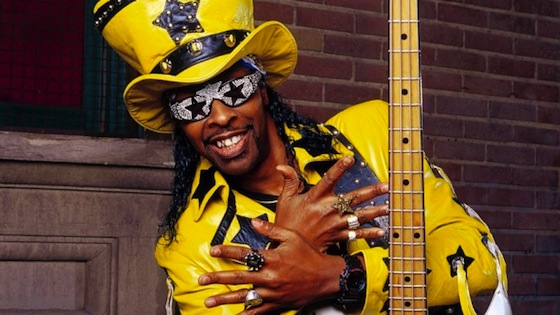
William “Bootsy” Collins represents the key aspect of funk for me. He was the first “bass hero” as it were. As part of the funk process,Larry Graham developed the vocabulary for it all to happen. And it was Bootsy who became in P-Funk what most lead guitarists do in rock bands. His bass was huge and flamboyant. And he made his “space bass” sound and image the start of the show with his Rubber Band,on his own and later with different session work. Of course,the story of how the Cincinnati native found fame through membership in the JB’s is well known. His beginnings with P-Funk are another matter.
Before Bootsy became a major player in the P-Funk arena,Funkadelic were more or less a groove acid rock jam band. And they had a slow,instrumentally raggedy approach. Especially in terms of rhythm. That gave them their uniqueness in the early 70’s. Bootsy arrived for their 1972 album America Eats Its Young. And he brought with his his profound sense of rhythm,and love of the singable melody. His personality shortly became as vital to P-Funk as George Clinton’s. In that way,he was able to change the face of P-Funk in the way he wasn’t as able to do in the strictly structured James Brown camp.
In all honesty,I haven’t yet heard everything that Bootsy has been instrumentally involved in. Especially in the 90’s,a number of musical projects in the Bill Laswell camp were utilizing Bootsy’s talents to provide the driving groove element to them. Today,I’d like to present to you some of the Bootsy solo/Bootsy related session work that I’m personally aware of. And that are personal favorites of mine. I am excluding his contributions to Parliament and Funkadelic,since that’s an article in and of itself. So here is Andresmusictalk’s rundown of personal Bootsy favorites.
‘Ahh,The Name Is Bootsy,Baby” (1977)
The groove on this song is both super clear and super punishing in terms of the funk. The deep,descending synth bass line alone makes the song. Not to even mention the horns and call/response vocals. Pretty much Bootsy’s defining song while leading the Rubber Band.
“Very Yes” (1978)
This punchy 1978 funk ballad was one I thought was sung by a very whispery female singer at first. Turns out this slow thump’s lead vocals were the work of Robert “P-Nut” Johnson. Just the combination of funkiness and quirkiness make this a very defining Bootsy number for me.
“She Jam” (Almost Bootsy Show)” (1979)
One of the reasons I enjoy this so much is that its a thick,throbbing Bootsy funk groove,as well as being an intricately written pop song. The combination of heavy funk instrumentation and melodic songwriting really make songs like this stand out.
“Its A Musical” (1980)
Bootsy utilizing his trademarked flamboyant,revved up bass style as the basic for every other instrumental and melodic idea of a song came to fruition on songs such as this “Its A Musical” did for Bootsy at the start of the 1980’s what “Bootzilla” and “Roto Rooter” had done a few years before.
“Hyper Space” by Sweat Band (1980)
This particular song by the Bootsy spin off Sweat Band is an instrumental that showcases P-Funk at its most melodically strong. The groove is an intense mix of synth bass,Clavinet and piano. The synthesizer plays a strongly modulating,jazzy theme as the main melodic theme,one the Clavinet also repeats. Some of P-Funk’s strongest music period.
“Shine-O-Mite (Rag Poping’)” (1982)
The bass/guitar interaction and sizzling synth interludes that define this groove make this what is,to me,some of the most slept on P-Funk of the early 80’s.
“Party On Plastic” (1988)
Took Bootsy awhile to make a comeback. But he came back in 1988 with a roar on his What’s Bootsy Doin’ album,a hard hitting electro funk set that is really defined by the sound of this song,its opener. It combines electronic drums,percussion and huge slap bass.
“Love Song” (1988)
Bootsy always had a way with writing funky love songs. On this,he did so in a pounding,ultra melodic Cameo-like funk manner. Always one of my favorite Bootsy numbers.
“Groove Is In The Heart” by Deee Lite (1990)
This funky house jam by the DJ collective Deee-Lite showcases not only Bootsy’s playing and influence. But is also loaded with his attitude and presence. In particular when he comes in saying “ASK YOUR MAMA!”.
So there you have it,my rundown on personal favorite Bootsy jams. There were others that were more defining and influential to other musicians,of course. Still,one of the most important aspects of Bootsy’s talents was being able to make hard funk somehow singable and accessible to people who were not heavily instrumentally inclined. That’s a combination that takes a lot of understanding. And generally a positive attitude. And those are two of the qualities that keep Bootsy’s music moving straight ahead onto where his funk will take him on its next journey.

